The Shade #1 (of 12)(DC Comics, $2.99)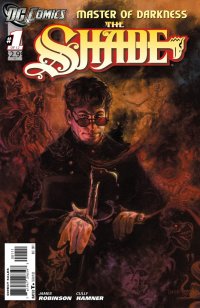
By Graig Kent
For about half its publishing life James Robinson’s Starman was one of the (no pun intended) brightest lights amidst the grim’n’gritty, bad girl-infested mainstream of the 1990’s. It was a unique title that managed to cover so many themes, and often many at the same time: father-son relationships; sibling rivalries; heroic legacy; local history; civic duty; good and evil and the grey stuff in between; rape; pop culture; collecting; the afterlife and more. Robinson’s presence was everywhere in the title, including the letters page which made it quite evident that the character of Jack Knight was quite loosely based on himself, the man he was. The flipside was the Shade, a former b-list supervillain whom Robinson not so much reformed, but fleshed out as a bored hero/villain dilettante, and perhaps the type of man Robinson wishes he was. The Shade is wry, suave, dapper, a romantic, wise but fallible, commonly apathetic, and has had generations to perfect his keenly honed persona.
It became evident, to me at least, about mid-way through Starman‘s 80-issue run that Robinson was bored, or at least less enthusiastic about chronicling Jack Knight’s adventures (after a time David Goyer joined him as co-writer), as if perhaps he’d exhausted much of his creative drive in the excellent first half. The stories and writing just didn’t seem as sharp, shocking or entertaining as they had been, and Robinson’s writing didn’t seem as crafted as it once was. Shortly after the end of Starman (and his excellent young-adult fantasy series Leave It To Chance) Robinson took a lengthy break from comics, returning with a Batman serial in 2006 followed by even higher profile runs on Superman and Justice League. Unfortunately that spice that Robinson had with the early Starman stories (and his work prior, like The Golden Age) never seemed to return. But there was one glimmer of the Robinson I remembered, a one-off Blackest Night tie-in, Starman “#81” which starred the Shade, and the writer’s reunion with the character made definite sparks.
So while Robinson has said, basically, “never again” to writing Jack Knight, he’s not abandoned Opal City, and he certainly hasn’t abandoned the Shade. Just as with with his last reunion with the character, sparks are flying once again, with a new 12 issue The Shade mini-series, the crux of which seems to be exploring his mysterious past — Robinson even teasing at his origin (though I doubt he will actually follow through completely… it’s almost best left a mystery) — while pushing the character forward. Now entangled in an awkward-yet-comfortable love affair with Hope O’Dare, The Shade finds himself kind of… happy, yet… bored. Hope encourages him to have an adventure, though one that stays on the right side of the law (she is a cop after all). But adventure finds him first in the shape of merc-for-hire/former ally Deathstroke, and halfway around the world, connected events occur in the form of a spectacular James Bond-of-Germany fashion.
Robinson’s scripting isn’t the tightest, I often had to reread conversations to get the flow and intonation right, but he’s certainly got his mojo flowing, something I wasn’t expecting to ever return, having actually gave up on him altogether a couple of years ago after once being a huge fan. He’s joined in the first arc of this mini-series with Cully Hamner who illustrates conversations with just as much gusto as his action sequences. Hamner’s heavy lines and clean layouts give the series an animated feel, perhaps not true-to-life, but definitely lively. Though I don’t recall him ever working on Opal City before he seems to have a sense of ease and familiarity in illustrating its denizens which makes it a warm read under a cool title. The art team is slated to rotate out throughout the series, with talent like Darwyn Cooke, Frazier Irving and Jill Thompson amongst the other names. This, from purely an artistic standpoint, is going to be a gem of a title.
Rating: 




Out of a Possible 5 Stars
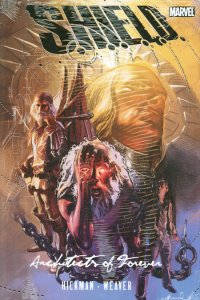 S.H.I.E.L.D.: Architects of Forever TPB (Marvel, $21.99)
S.H.I.E.L.D.: Architects of Forever TPB (Marvel, $21.99)
By Adam Prosser
Something interesting tends to happen to pop culture properties when they’ve been around for a while; it’s an especially common phenomenon among superhero comics, with their elaborate universes and dense continuity. The narrative doesn’t just build forwards and outwards, but backwards. The saga of the Marvel Universe is revealed not to have begun with the events of Fantastic Four #1, or even with the Human Torch and the Sub-Mariner in the 1930s; an elaborate history is developed going back for years, centuries even, grounding the events of the current world in some kind of epochal saga that resonates through the ages. Suddenly the often incidental events that shaped our favourite characters are revealed as something that has precedent, that was often fore-ordained years before, turning the stories into the fulfillment of destiny or the turning point in struggles that reach back to the dawn of time. Retroactive continuity is the word. Ret-con.
I’m always a little torn on this. Characters, and the world they inhabit, need a history, and telling the story of “what came before” is often fun and can even be psychologically or thematically revealing. But on the other hand…well, I think we can all agree that learning Darth Vader built C-3PO and that Boba Fett was a clone detracted from, rather than enhanced, the original Star Wars movies, right? Even relatively benign retcons like, say, learning that Tony Stark’s dad helped create Captain America, can threaten to make the world of a story seem small and filled with unlikely coincidences, or undermine the uniqueness of the modern-day heroes. If Tony Stark and Reed Richards are the scions of a dynasty of super-scientific geniuses, rather than self-made men, doesn’t that make them seem…a little less special?
There’s also the fact that rooting elements of a fictional world in centuries-old conflict can sometimes distort the original purpose of those creations. Take S.H.I.E.L.D., for example. Created in their fertile period of the mid-60s by Stan and Jack as a secret government espionage agency employing Nick Fury, the miniseries Architects of Forever by Jonathan Hickman and Dustin Weaver imagines an epic history for the organization, stretching all the way back to ancient Egypt and incorporating many of the great scientifically and mystically-inclined personalities of history, from Isaac Newton and Leonardo Da Vinci to Nikola Tesla, along with the aforementioned Stark and Richards patriarchs. They’re basically the Illuminati, the Knights Templar and the Freemasons all rolled into one, engaged in a series of struggles to protect the world and advance the cause of human understanding. Along the way they’ve developed the key to immortality, invented space travel 500 years early, and saved the world numerous times (including from a clash with Galactus centuries ago that was solved through particularly brain-boggling, but undeniably effective, means).
The story proper actually focuses on a young man named Leonid, recruited into S.H.I.E.L.D. in the 50s and taken to their secret underground city beneath Rome. Leonid is the son of a superbeing (whether hero or villain is rather ambiguous) called The Night Machine, and has some kind of ill-defined celestial power that the masters of S.H.I.E.L.D., led by the centuries-old Isaac Newton, wish to harness. His arrival, however, triggers a series of events culminating in the return of Leonardo Da Vinci and the fragmenting of S.H.I.E.L.D. into two factions, each following one of the great geniuses, that inevitably come into conflict.
There are a lot of fascinating ideas here, and Hickman and Weaver have undeniably added a lot to the mythology of the Marvel Universe. I particularly like the way they’ve repurposed many of the legendary inventors and thinkers of history as proto-superheroes, because, in the Marvel universe, why wouldn’t they be? But as suggested above, the problem is that S.H.I.E.L.D. may not be the right outlet for these ideas. I have to admit, I’ve always preferred the idea that S.H.I.E.L.D. is a modern, governmental reaction to the proliferation of crazy superbeings in the world, regular humanity trying desperately to keep up with the weirdness suddenly sprouting up around them. Turning it into an ancient mystical order of super-scientists makes it seem like they’re just part of the weirdness themselves—hell, with this new historical perspective, S.H.I.E.L.D.’s doings make the adventures of the Fantastic Four and the Avengers seem like just another day at the office. You can only go so big before you start to make everything else seem small.
This would be a pretty minor complaint, though, if it weren’t for the fact that this story is a bit of a mess. I’ve been a fan of much of Hickman’s work, and he doesn’t fail to bring the level of imagination and inventiveness I’ve come to expect from him, but it’s in the service of a surprisingly hollow story. Fans of steampunk will be in heaven (Weaver’s lovely, detailed art provides page after page of wonderfully anachronistic doodads and other wonderfully crazy visuals), but Hickman’s central themes of free will and imagination vs. pragmatism and predetermination are surprisingly half-baked. He also employs a narrative style that jumps around in time, showing us plenty of fascinating sights but generating very little momentum. It’s rarely clear what the stakes are or what’s motivating the characters. I mean, Leonid himself is barely fleshed out as a character, and by the end of the book we have very little idea of who he is, what he wants, or even what he can do.
It kind of breaks my heart to give such a low rating to a book this beautiful, this bursting with energy and good intentions, in an age when too many superhero comic writers are spending all their time trying to come up with new reasons for Spider-man to fight the Green Goblin. But the fact of the matter is that this is more an outline than an actual story, giving us a whirlwind tour of a rich and detailed world but not making much of an attempt to actively engage us in it. Hickman may nominally emphasize more with Da Vinci’s quest to elevate the human spirit above the rules that have been set for it, but in practice this book seems to side more with Newton’s cold, clockwork vision of the universe: intricate, detailed, and inhuman.
Rating: 




Out of a Possible 5 Stars
Pilot Season: The Beauty (Top Cow, Image, $3.99)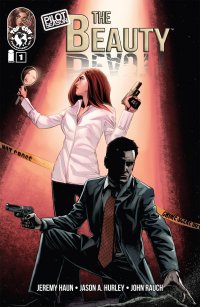
By Jeb D.
If there’s one thing that the average comic book artist knows how to do, it’s draw good-looking people. Only makes sense, really: the books that everyone uses when they are learning teach you how to draw idealized versions of the human form. As you go along, well… as Terry Moore has said, the reason that Strangers in Paradise became a story about two women, instead of a man and woman, was that he simply preferred drawing women; similarly, a lot of artists would just prefer to draw attractive characters, regardless of story needs. And, of course, pictures of pretty folks are easier to market, particularly in the already-fantastic world of superheroes that still dominate the marketplace.
Which poses kind of a quandary for a comic like this one: when a key element of your story depends on a class of people who are markedly more beautiful than anyone else, the visual differentiation is particularly important. In this latest “Pilot Season” outing, artist and cowriter Jeremy Haun attempts to portray that contrast in a more or less realistic way that focuses us not on the story’s unique qualities, but on its conventional ones.
The Beauty is, basically, a cop show. Our protagonists are a pair of detectives whose latest homicide case takes an unexpected turn, they find their investigation impeded by Federal interference, they chase down a perp who reveals that there are even deeper layers here (while dying before we learn any more), and they find that the case has begun to hit home in unexpectedly personal ways.
There’s a high concept behind it, of course: a new strain of STD is causing people to become “beautys”: “Fat melted away, thinning hair returned, skin blemishes faded, and facial features slimmed,” though everyone tends to shrug off the mysterious fever and other symptoms that come along with it. And with the population now divided roughly in half between those with The Beauty, and those without it, anti-beauty hate crime is common. Given the exigencies of cramming a lot into a single issue, all of that is laid out in a couple of recap pages, which always presents a storytelling challenge: this kind of world-building works much better when it can develop organically, investing the reader in it, which is one reason writers “show” rather than “tell.” More to the point, once the ground rules have been established, this first issue really does run a fairly standard police-procedural playbook. That’s not to say that Haun and co-write Jason A. Hurley couldn’t eventually take this story in unexpected directions, but for its “pilot” issue, ideas are decidedly taking a backseat to formula.
And despite the fact that I don’t think Haun does as good a job as he might in creating a world where beauty is clearly distinct from the ordinary (detective Kara Vaughn, who is a Beauty, looks pretty much like every pantsuited female cop you’ve ever seen), that would be my only reservation about the art: the paneling is effective and imaginative, his use of body language reinforces and expands on the functional dialogue, and the action beats may be cliché CSI stuff, but they’re handled well. My other reservation about the art would be the way that it telegraphs punches (the final panel of the book is a reveal that we’re already expecting, given the pains he takes to hide it on the preceding pages), but again, that’s partially due to the need to throw a lot of bang! into this one issue, in hopes of seeing the story continue: with a firmer commitment to an extended run, my guess is that this book would breathe a bit more.
Tough call: on the one hand, I’d suggest waiting for reactions to the first story arc, to see if The Beauty develops into something that can transcend its more conventional elements. On the other hand, of course, the question of whether or not it will continue is dependent on buyers NOT waiting. Still, there are other books out there equally in need of your support, that will give you back more bang for your buck.
Rating: 




Out of a Possible 5 Stars
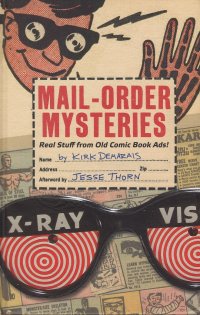 Mail Order Mysteries: Real Stuff from Old Comic Book Ads! (Insight Editions, $19.95)
Mail Order Mysteries: Real Stuff from Old Comic Book Ads! (Insight Editions, $19.95)
By Graig Kent
Taking a little detour from the usual floppies and graphic novels, here we have a book (!?) that should pique the interest of any comic collector who grew up in the ’60’s, ’70’s or ’80’s.
Writer/collector Kirk DeMarais has had a long-standing fascination with those jam-packed mail-order advertisement pages in comic books past, in fact from his introduction, it would seem DeMarais was one of those kids who got more out of scouring over the ads and fantasizing about what they were and could do than the content of the comic (akin to someone who prefers reading the articles in Playboy to looking at the pictures). I mean, sure, those of us who read comics at that time were all a little curious (though I don’t know anyone personally who was ever curious enough to ever buy anything from them), however unlike DeMarais, we kind of just gave up on wondering. But every time you peruse a back-issue from the period, don’t you still wonder, just a little bit, about what they’re really selling?
DeMarais has spent years, and real money (a lot more money than $1 plus 25 cents for S&H) scouring the internet to snatch up vintage mail order oddities such as the classic X-Ray Spex, 100 Toy Soldiers, Triple-Flips and the Raquel Welch Pillow. He’s gathered his findings into this exquisitely designed tome, each page featuring the original ad (or ads), plus a picture of what you really got, and a bit of commentary, typically broken into 3 parts (“We Imagined”, “They Sent”, and “Customer Satisfaction” with an occasional fourth, “Behind The Mystery”). As we all suspected, most of the items were not as they were made out to be in our juvenile brains, although a few were on the level. It’s interesting as an adult to note the carefully chosen language in the ads and how they can stimulate an innocent and ignorant imagination, and still see how the final product, the novelty crap, was actually represented accurately.
In the days of the internet, you can assuredly find all the information within this book scattered around the web or perhaps even in a single website somewhere, but Mail Order Mysteries has style and plenty of it. Beneath a glow in the dark hardcover are over 150 full color pages (many of them four-color blow-ups that would get Roy Lichtenstein excited), loaded with pictures and DeMarais playful humor. If I had to complain, I would have liked more analysis of the wordplay used in the advertisements, and perhaps a more in-depth look at the hows and whys of these products, contextualizing the appeal of them at the time. Even still it’s a thoroughly entertaining nostalgia trip, one that should sit out and be thumbed through rather than sit on a shelf. Amaze your friends! Protect yourself from bullies! 100 different uses!
Rating: 




Out of a Possible 5 Stars
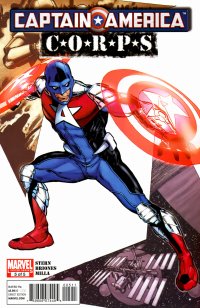 Captain America Corps #5 of 5 (Marvel, $2.99)
Captain America Corps #5 of 5 (Marvel, $2.99)
By Jeb D.
When people talk about “old-school” comic storytelling, as often as not this is the kind of thing they mean, and while I’m basically down with its vintage silliness, it’s not going to be to everyone’s taste.
It’s timeslip/alternate universe time: Captain Americas from various corners of the mulitverse have been removed from their respective worlds, before “fulfilling their destiny as an Avenger.” Never fear, though: an interdimensional team of Caps (including WWII-era Steve Rogers, the USAgent, American Dream, and James Barnes) has been assembled to get to the bottom of this. The evil Americommand terrorist group is responsible, and with the aid of their super-powered Ameridroid have converted the 21st century into a kind of slave-labor camp, with a motley assortment of Marvel heroes from various times and places (including Wyatt Wingfoot, Frank Castle, Peter Parker, Luke Cage, and Hank McCoy) serving as an underground resistance; the Cosmic Cube, you won’t be surprised to learn, is involved. This concluding issue is (naturally) their final battle: some will live, some will die!
No question, writer Roger Stern is about as old-school as it gets, and while there’s the odd groaner here and there in the dialogue (“Not so big now, are ya?” “Fools! You think the odds have swung in your favor?“), he fills the plethora of word balloons with that exuberant 70’s-era Avengers feel (everyone calling each other by name so you can keep the cast of dozens straight), and adds such welcome touches as Hank reverting to his original X-Men version of Beast. Artist Philippe Briones needs a bit of work on facial consistency, but when you’re mostly called on to deliver page after page of punchups, it’s not a huge problem; colorist Matt Milla keeps the vibe vintage.
Of course, in a marketplace where it’s not usually hard to find trade paperback editions of vintage Avengers comics, the eventual collection of something like Captain America Corps would be tough to recommend instead. But if you just need a quick injection of what the House of Ideas used to feel like, give it a shot.
Rating: 




Out of a Possible 5 Stars